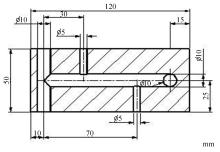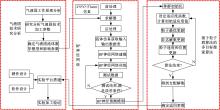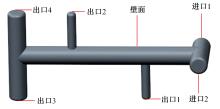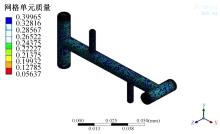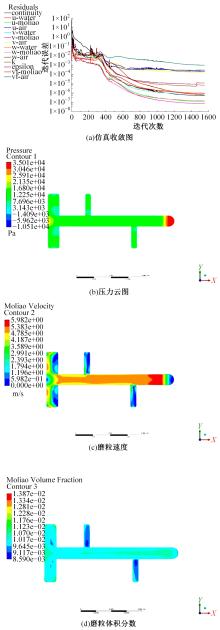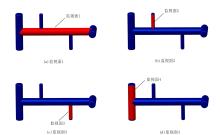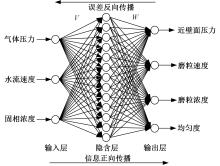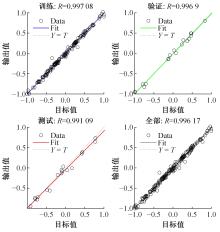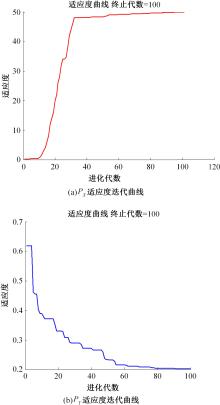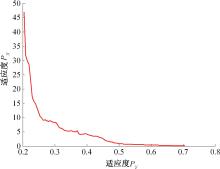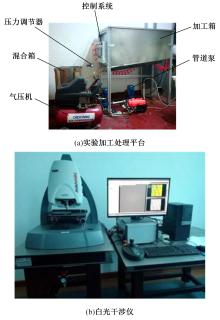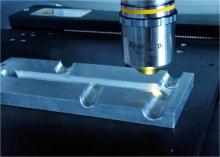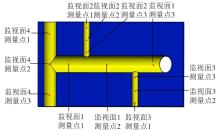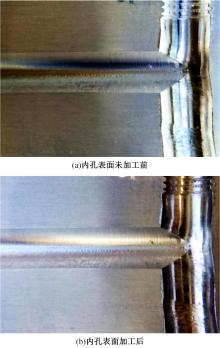Journal of Jilin University(Engineering and Technology Edition) ›› 2024, Vol. 54 ›› Issue (6): 1537-1547.doi: 10.13229/j.cnki.jdxbgxb.20230025
Internal surface treatment of gas-liquid-solid technology based on improved neural network and Fluent
Guang-bao LI1,2( ),Dong GAO2,Yong LU2,Hao PING1,Yuan-yuan ZHOU1
),Dong GAO2,Yong LU2,Hao PING1,Yuan-yuan ZHOU1
- 1.Shanghai Aerospace Precision Machinery Research Institute,Shanghai 201600,China
2.School of Mechanical and Electrical Engineering,Harbin Institute of Technology,Harbin 150001,China
CLC Number:
- TG664
| 1 | 王杰,李爱蓉.小波包分析识别气液固三相流流型[J].石油化工,2020(1):62-69. |
| Wang Jie, Li Ai-rong. Identification of gas-liquid-solid three-phase flow pattern by wavelet packet analysis[J]. Petrochemical Industry, 2020(1):62-69. | |
| 2 | 辛亚男,张建文,姜爱国.一种新型螺旋内槽管的气液固三相流数值模拟研究[J].计算力学学报,2018(2):238-248. |
| Xin Ya-nan, Zhang Jian-wen, Jiang Ai-guo. Numerical simulation of gas-liquid-solid three-phase flow of a new type of spiral inner groove tube[J]. Journal of Computational Mechanics, 2018(2):238-248. | |
| 3 | 黄豆豆,计时鸣,陈国达,等.气液固三相湍流环境中气泡破裂对SiC颗粒的影响研究[J].机电工程,2017,34(9):965-970. |
| Huang Dou-dou,Timing, Chen Guo-da,et al. Study on the influence of bubble burst on SiC particles in gas-liquid-solid three-phase turbulent environment[J]. Electromechanical Engineering, 2017,34(9):965-970. | |
| 4 | 杨建.水力空化气液固三相磨粒流抛光工具及系统研究[D].杭州:浙江工业大学机械工程学院,2019. |
| Yang Jian. Study on polishing tools and systems of hydraulic cavitation gas-liquid-solid three-phase abrasive flow[D]. Hangzhou:College of Mechanical Engineering,Zhejiang University of Technology, 2019. | |
| 5 | 胡焰.基于气液固混合的磨料射流加工系统及实验研究[D].南京:南京航空航天大学机电学院,2019. |
| Hu Yan. Abrasive jet machining system and experimental study based on gas-liquid-solid mixing[D].Nanjing: School of Mechanical and Electrical Engineering, Nanjing University of Aeronautics and Astronautics, 2019. | |
| 6 | 李瑞光,丁宇亭,杨增辉,等.航天伺服阀阀套相交孔磨粒流工艺技术研究[J].液压气动与密封,2022,42(7):109-112. |
| Li Rui-guang, Ding Yu-ting, Yang Zeng-hui,et al. Study on abrasive flow technology of intersecting hole of aerospace servo valve sleeve[J]. Hydraulic Pneumatic and Sealing, 2022,42(7):109-112. | |
| 7 | 计时鸣,曹慧强,赵军,等.三相磨粒流文丘里管结构空化辅助抛光机理与试验[J].农业工程学报,2018,34(16):71-79. |
| Timing, Cao Hui-qiang, Zhao Jun,et al. Cavitation-assisted polishing mechanism and experiment of three-phase abrasive flow venturi tube structure[J]. Journal of Agricultural Engineering, 2018,34(16):71-79. | |
| 8 | 王景坡,宋超,凌洋,等.多通管接头磨粒流光整均匀性研究[J].表面技术,2022,(4):299-307. |
| Wang Jing-po, Song Chao, Ling Yang,et al. Study on abrasive particle polishing uniformity of multi-port pipe joints[J]. Surface Technology, 2022(4):299-307. | |
| 9 | 李晓波,魏武,才冬涛,等.基于磨粒流技术的阀块内孔道光整加工[J].金属加工(冷加工),2022(3):20-24. |
| Li Xiao-bo, Wei Wu, Cai Dong-tao,et al. Finishing of inner bore of valve block based on abrasive flow technology[J]. Metalworking (Cold Working), 2022(3):20-24. | |
| 10 | 王卫东.自激振荡脉冲空化射流喷嘴多目标优化研究[D].秦皇岛:燕山大学机械工程学院,2021. |
| Wang Wei-dong. Study on multi-objective optimization of self-excited oscillation pulsed cavitation jet nozzle[D]. Qinghuangd:School of Mechanical Engineering, Yanshan University, 2021. | |
| 11 | 褚聪,戴勇,沈明,等.基于Fluent仿真的强约束磨粒射流抛光特性[J].表面技术,2016(6):198-204. |
| Chu Cong, Dai Yong, Shen Ming,et al. The polishing characteristics of strongly constrained abrasive jet based on Fluent simulation[J]. Surface Technology, 2016(6):198-204. | |
| 12 | 刘江,黄晓斌,何吕,等.基于Fluent的喷油嘴倒锥孔磨粒流加工数值模拟[J].机械制造与自动化,2021,50(2):40-42, 50. |
| Liu Jiang, Huang Xiao-bin, He Lyu,et al. Numerical simulation of abrasive flow machining in the inverted cone hole of fuel injector based on Fluent[J]. Machinery Manufacturing and Automation, 2021,50(2):40-42, 50. | |
| 13 | 李研彪,陈强,张利.钛合金薄壁曲面液态金属-磨粒流加工仿真与试验研究[J].机械工程学报,2021(23):220-231. |
| Li Yan-biao, Chen Qiang, Zhang Li. Simulation and experimental study on liquid metal-abrasive flow machining of titanium alloy thin-walled curved surface[J]. Journal of Mechanical Engineering, 2021(23):220-231. | |
| 14 | 刘洋,李俊烨,苏宁宁,等.磨粒流抛光弯管的数值模拟与试验优化[J].机械设计与制造,2021(7):137-140. |
| Liu Yang, Li Jun-ye, Su Ning-ning,et al. Numerical simulation and experimental optimization of abrasive flow polishing bend[J]. Mechanical Design and Manufacturing, 2021(7):137-140. | |
| 15 | 计时鸣,葛江勤,谭大鹏,等.三相磨粒流抛光及其气泡溃灭分布特性[J].光学精密工程,2018(2):388-398. |
| Timing, Ge Jiang-qin, Tan Da-peng,et al. Three-phase abrasive flow polishing and bubble collapse distribution characteristics[J]. Optical Precision Engineering, 2018(2):388-398. | |
| 16 | 姚燕生,周瑞根,张成林,等.增材制造复杂金属构件表面抛光技术[J].航空学报,2022(4):244-256. |
| Yao Yan-sheng, Zhou Rui-gen, Zhang Cheng-lin,et al. Surface polishing technology of complex metal components manufactured by additives[J]. Acta Aeronautical, 2022(4):244-256. | |
| 17 | 李光保.基于三相流技术的零件内表面毛刺处理的系统研究[D].哈尔滨:哈尔滨工业大学机电工程学院,2019. |
| Li Guang-bao. Systematic research on burr treatment of parts inner surface based on three-phase flow technology[D]. Harbin:School of Mechanical and Electrical Engineering, Harbin Institute of Technology, 2019. | |
| 18 | 张方东.磨料流加工工件表面粗糙度研究[J].现代制造技术与装备,2020,56(10):162-163. |
| Zhang Fang-dong. Study on the surface roughness of abrasive flow machining workpiece[J]. Modern Manufacturing Technology and Equipment, 2020,56(10):162-163. |
| [1] | Xi-guang ZHANG,Long-fei ZHANG,Yu-xi MA,Yin-ting FAN. Design of fuzzy clustering algorithm for massive cloud data based on density peak [J]. Journal of Jilin University(Engineering and Technology Edition), 2024, 54(5): 1401-1406. |
| [2] | Chao XIA,Meng-jia WANG,Jian-yue Zhu,Zhi-gang YANG. Reduced-order modelling of a bluff body turbulent wake flow field using hierarchical convolutional neural network autoencoder [J]. Journal of Jilin University(Engineering and Technology Edition), 2024, 54(4): 874-882. |
| [3] | Guo-jun YANG,Ya-hui QI,Xiu-ming SHI. Review of bridge crack detection based on digital image technology [J]. Journal of Jilin University(Engineering and Technology Edition), 2024, 54(2): 313-332. |
| [4] | Hai-long GAO,Yi-bo XU,Kun LIU,Chun-yang LI,Xiao-yu LU. High-speed highway road network short-term traffic flow parameters based on multi-source data fusion prediction [J]. Journal of Jilin University(Engineering and Technology Edition), 2024, 54(1): 155-161. |
| [5] | Shuang LI,Zi-rui LIN,Song YE,Xu LIU,Ji-song ZHAO. Orbital capability evaluation and trajectory reconstruction for launch vehicle with thrust decline [J]. Journal of Jilin University(Engineering and Technology Edition), 2023, 53(8): 2245-2253. |
| [6] | Xiang-jiu CHE,Huan XU,Ming-yang PAN,Quan-le LIU. Two-stage learning algorithm for biomedical named entity recognition [J]. Journal of Jilin University(Engineering and Technology Edition), 2023, 53(8): 2380-2387. |
| [7] | Feng LYU,Nian LI,Zhuang-zhuang FENG,Yang-hang ZHANG. Method of collaborative filtering recommendation of personalized product-service system based on user [J]. Journal of Jilin University(Engineering and Technology Edition), 2023, 53(7): 1935-1942. |
| [8] | Peng-ju LIU. Design of automatic identification algorithm for Internet of Things security situation based on deep neural network [J]. Journal of Jilin University(Engineering and Technology Edition), 2023, 53(7): 2121-2126. |
| [9] | Pei-yong LIU,Jie DONG,Luo-feng XIE,Yang-yang ZHU,Guo-fu YIN. Surface defect detection algorithm of magnetic tiles based on multi⁃branch convolutional neural network [J]. Journal of Jilin University(Engineering and Technology Edition), 2023, 53(5): 1449-1457. |
| [10] | Zhen-hai ZHANG,Kun JI,Jian-wu DANG. Crack identification method for bridge based on BCEM model [J]. Journal of Jilin University(Engineering and Technology Edition), 2023, 53(5): 1418-1426. |
| [11] | Yan-tao TIAN,Fu-qiang XU,Kai-ge WANG,Zi-xu HAO. Expected trajectory prediction of vehicle considering surrounding vehicle information [J]. Journal of Jilin University(Engineering and Technology Edition), 2023, 53(3): 674-681. |
| [12] | Ya-jing YU,Jian GUO,Rong-hao WANG,Wei QIN,Ming-wu SONG,Zheng-rong XIANG. Time⁃varying formation control of multi⁃quadrotor unmanned aerial vehicles based on state observer [J]. Journal of Jilin University(Engineering and Technology Edition), 2023, 53(3): 871-882. |
| [13] | Shuai-shuai ZHANG,Yan-fang YIN,Lin-jing XIAO,Shuai JIANG. Static gait planning method for quadruped robot based on gate recurrent neural network [J]. Journal of Jilin University(Engineering and Technology Edition), 2023, 53(3): 902-912. |
| [14] | Rong-han YAO,Wen-tao XU,Wei-wei GUO. Drivers' takeover behavior and intention recognition based on factor and long short⁃term memory [J]. Journal of Jilin University(Engineering and Technology Edition), 2023, 53(3): 758-771. |
| [15] | Jin-Zhen Liu,Guo-Hui Gao,Hui Xiong. Multi⁃scale attention network for brain tissue segmentation [J]. Journal of Jilin University(Engineering and Technology Edition), 2023, 53(2): 576-583. |
|
||
